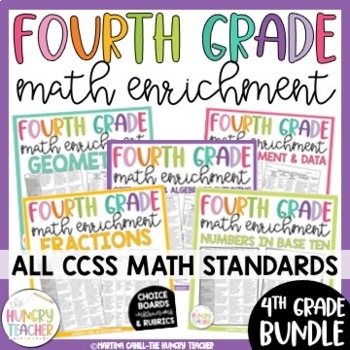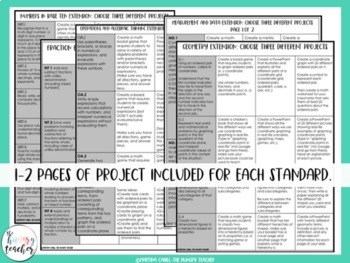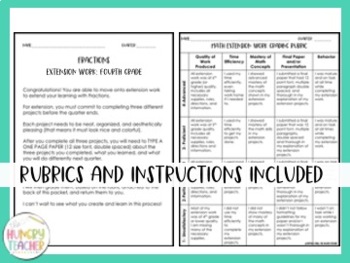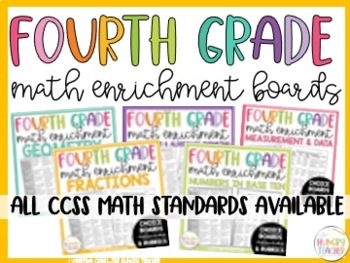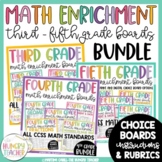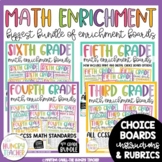Math Enrichment Boards for Fourth Grade | Math Choice Boards
Martina Cahill - The Hungry Teacher
35k Followers
Grade Levels
4th
Subjects
Resource Type
Standards
CCSS4.MD.A.1
CCSS4.MD.A.2
CCSS4.MD.A.3
CCSS4.MD.B.4
CCSS4.MD.C.5
Formats Included
- Zip
Pages
30 pages
Martina Cahill - The Hungry Teacher
35k Followers
What educators are saying
I loved the ease of prepping these activities. It was nice that I didn't need to reexplain directions since they were similar. My students liked playing games.
I used this for a student who needed more enrichment during our math block. She loved it. Very engaging.
Products in this Bundle (5)
Also included in
- This resource includes math enrichment choice boards, rubrics, and instructions for every single 3rd, 4th, and 5th math Common Core State Standard. These are great for early finishers and students who need enrichment in math. Save 25% by purchasing the bundleIncluded in this resource are the followiPrice $25.60Original Price $34.00Save $8.40
- This HUGE BUNDLE includes twelve of my best-selling fourth and fifth-grade math resources for Operations and Algebraic Thinking, Measurement and Data, Fractions, Numbers in Base Ten, and Geometry. This bundle gets you more than 20% savings.Click on any of the links below to check out these resourcesPrice $49.99Original Price $88.35Save $38.36
- This resource includes math enrichment choice boards, rubrics, and instructions for every single 3rd, 4th, 5th, and 6th grade math Common Core State Standard. These are great for early finishers and students who need enrichment in math. Save 30% by purchasing the bundleIncluded in this resource arePrice $19.99Original Price $45.41Save $25.42
Description
Included in this pack are the fourth grade math enrichment boards I use for fourth grade learners who have mastered any of our fourth grade math concepts and are now ready for a challenge. These choice boards give students choice, ownership, and a challenge through focused standard based projects.
The choice boards are broken up by each standard so that students who need enrichment can focus on the standard(s) you think they are ready for.
There are three different activities for every single CCSS math standard for 70+ different extension activities.
Also included are instructions for students and rubrics for assessing student enrichment work.
Also Available:
Total Pages
30 pages
Answer Key
N/A
Teaching Duration
Lifelong tool
Report this resource to TPT
Reported resources will be reviewed by our team. Report this resource to let us know if this resource violates TPT’s content guidelines.
Standards
to see state-specific standards (only available in the US).
CCSS4.MD.A.1
Know relative sizes of measurement units within one system of units including km, m, cm; kg, g; lb, oz.; l, ml; hr, min, sec. Within a single system of measurement, express measurements in a larger unit in terms of a smaller unit. Record measurement equivalents in a two-column table. For example, know that 1 ft is 12 times as long as 1 in. Express the length of a 4 ft snake as 48 in. Generate a conversion table for feet and inches listing the number pairs (1, 12), (2, 24), (3, 36),...
CCSS4.MD.A.2
Use the four operations to solve word problems involving distances, intervals of time, liquid volumes, masses of objects, and money, including problems involving simple fractions or decimals, and problems that require expressing measurements given in a larger unit in terms of a smaller unit. Represent measurement quantities using diagrams such as number line diagrams that feature a measurement scale.
CCSS4.MD.A.3
Apply the area and perimeter formulas for rectangles in real world and mathematical problems. For example, find the width of a rectangular room given the area of the flooring and the length, by viewing the area formula as a multiplication equation with an unknown factor.
CCSS4.MD.B.4
Make a line plot to display a data set of measurements in fractions of a unit (1/2, 1/4, 1/8). Solve problems involving addition and subtraction of fractions by using information presented in line plots. For example, from a line plot find and interpret the difference in length between the longest and shortest specimens in an insect collection.
CCSS4.MD.C.5
Recognize angles as geometric shapes that are formed wherever two rays share a common endpoint, and understand concepts of angle measurement:

